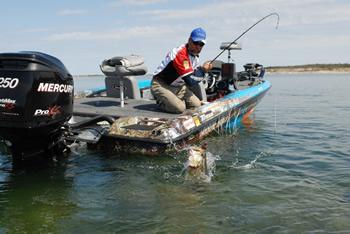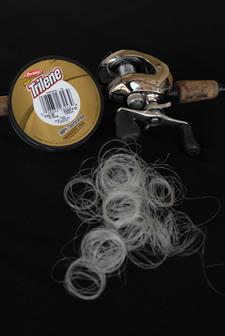January 12, 2018 - There is no such thing as a bad time to hook up with a big Texas bass, but there is plenty of evidence to show when the odds of getting the big bite are best. More than three decades worth of data collected by the Toyota ShareLunker program indicates that the four-period spanning January through April is prime time to catch a big bass with a weight problem.
ShareLunker is an angler recognition program run by the Texas Parks and Wildlife Department since Nov. 1986. Up until this year, the threshold for entry to program has been 13 pounds.
Of the 570 ShareLunkers documented during the last 31 years, 241 were caught during March. The second leading month is February (132) entries, followed by April (89 entries) and January (58).
Not surprisingly, the Top 50 list of Texas' heaviest bass of all-time reflects a similar trend, although the spreads are aren't near as wide. March is the No. 1 month for Top 50 fish with 15 entries, but running a really close second is February with 14. January is third with seven entries, while April and May have kicked out two Top 50 each.
The only other months with more than one Top 50 fish are August and September, both with two fish. October, November, December and July account for the remainder of the Top 50 with one entry apiece. June is the only month out of 12 not found on the prestigious Top 50 list.
One of the main reasons why more big bass are caught in late winter and early spring is because that's when the fish are plump with eggs. Fisheries biologists have learned that the weight of a mature female bass may increase as much as 10 percent when its ovaries are full.
In other words, a fish that weighed 10 pounds in July could easily weigh 11 pounds early in the year. It could weigh even more after consuming a healthy meal comprised of a two-pound crappie or a couple of big bar fish, which happens pretty frequently. Two years ago, ShareLunker caretaker Tony Owens found dead crappie floating around in hatchery raceways that were occupied by fresh-caught ShareLunkers. He believes the big fish regurgitated the smaller fish soon after their arrival at the Texas Freshwater Fisheries Center in Athens.
Timing is big factor is linked to high incidence of big bass catches this time of year. On many reservoirs, particularly those in eastern and South Texas, now is when the biggest fish in the lake will begin nudging their way towards the shallows to spawn.
Fish that are positioned near the bank are much more vulnerable to being caught than those far from shore, mainly because that is where most anglers feel the most comfortable fishing. More hooks in high percentage water naturally boosts the chances of big fish getting caught.
Translation: We're on the cusp of another big bass season in Texas.
There are all sorts of worthwhile tips to offer that might help anglers boost their odds of catching a big fish, but might be a better idea to offer up some advice to help fishermen reduce the chances of losing one when it grabs the bait.
All sort bad things can happen a giant bass comes calling. Here are some things anglers can do to help prevent a train wreck from happening:
Think Big on Line
One of the best ways to commit big bass suicide is to spool a reel with inferior fishing line that isn't up to the task. Fishing lines are rated by pound test. A line that is rated as 14-pound test should be able to withstand 14 pounds of pressure before it breaks.
Plenty of big bass have been landed on lighter lines, but tossing a lure into a lake known for producing the big bite with anything less than 14-pound test is risky business. Big bass are typically caught in relation to heavy cover and they know how to use it to their advantage.
Go Fresh
Monofilament and fluorocarbon fishing lines can become dry and brittle with time, which can result in a significant loss in strength. It's always a good idea to respool reels with fresh line at the beginning of each fishing season. Depending on how much you fish, you may need to respool periodically over the course of the year.
There is no sense in refilling the entire spool when changing line. In fact, it's a waste of time, good line and money.
Most low profile reel spools will hold well over 100 yards of 14-pound line, but most anglers seldom cast beyond 40-50 yards. Rather than emptying full spool, peel off about 60 yards of line off the top layer, cut it and tie the new line to the backing. When refilling the spool hold the line snug to ensure it goes onto the spool tight.
If you're filling a new reel for the first time, it's a good idea to use some cheap or old line to fill the spool to the halfway point, then use a premium line to top it off.
Don't Get Nicked
Modern fishing lines are more resistant to abrasion than ever before, but they aren't indestructible. When you catch a fish or get hung in brush or on rocks, always inspect your line for nicks or frays that could create a weak spot and cause the line to snap under way less pressure than it should.
Line crimps created by backlashes can be demons in disguise, especially with fluorocarbon lines. The crimp automatically creates a weak spot that could cause the line to for break for no apparent reason.
Something else that can result in premature line breakage is a cracked insert in the line guide on your rod. Most inserts are made from ceramic material. If the ceramic insert cracks it could create a sharp edge capable of cutting your line like a knife. If the line breaks the hookset, cracked insert could be the culprit. The best way to check line guides for cracks is to use a Q-Tip to swab the inner wall. If the cotton snags, the ceramic insert should be replaced.
Routine Drag Checks
One of the best ways to lose a big fish is to have the star drag on your reel set too tight or too loose. The drag is intended to allow the reel spool to turn and release line under the pressure of a large fish. A drag that is set too tight could result in line breakage before the spool has the opportunity to slip. A drag that is set too loose could allow a big fish to get the upper hand and get you hung up, or result in poor hook penetration.
It is always a good idea to check your drag periodically to make sure it is set properly. To do this, make sure the reel gears are engaged. Grasp line ahead of the spool and pull. If the drag doesn't slip under hard pressure, it should be backed off until it does. If it slips under light pressure, tighten it accordingly.
Constant Pressure
Give a big bass an inch and it'll take a mile every time. Sometimes there isn't much you can do other than hold on and hope for the best. Big fish like to hang out around thick cover. It is always best to maintain constant pressure and try to get the fish coming your way as quickly as possible. If your line goes slack there is a good chance the fish could shake the lure.
Tie Good Knots
The line is a critical link between the angler, the lure and the fish. The knot is what ties it all together.
Tying a faulty knot or one that isn't suited for the application can spell disaster when a big bass comes calling.
Always make sure your knots come together smoothy and easily when you cinch them down. A straggling loop or twist in a knot is good sign that something got fouled up in the process. It only takes a few seconds to start over and retie. And be sure and wet the knot with saliva before snugging it tight. Otherwise you'll burn the line and create a weak spot.
Net Jobs
The guy with the net can be your best friend or very worst enemy. I hear all kinds of horror stories from from tournament pros whose co-anglers have cost them dearly by causing them to lose fish at the boat because they didn't know how to handle a fish net properly.
Never try to scoop or stab at the fish from the top with the net. Instead, lay the net at a slight, downward angle in the water and let the angler bring the fish to you. Be ready to react in case the fish darts, dives or jumps.
If your partner doesn't know how to to net fish, show him or her ahead of time. Otherwise, you might be better off handling the job yourself.
Big bites don't come along very often. It pays to be prepared when Lady Luck looks your way. It can cost you dearly when you aren't.

Things can go awry when a big bass comes calling, even when you are prepared. Here, the late Ken Cook shows how it's done at Lake Amistad. (Photo by Matt Williams)

Old fishing line should be discarded and replaced with new line at least once a year, possibly more if you spend a lot of time on the water. It's also a good idea to replace line if the reel backlashes. (Photo by Matt Williams)
Matt Williams is a freelance writer based in Nacogcoches. He can be reached by e-mail, mattwillwrite4u@yahoo.com.









